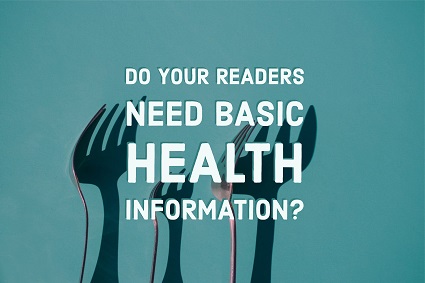Your cart is currently empty!

Basic Health Information at Your Blog
Healthcare content marketing increases the value and visibility of your website, brings in new patients, brings established patients in more frequently, makes patients aware of services you offer, helps recruit new team members — and gives healthcare marketers an opportunity to help increase health literacy. Research shows that the internet is now the top source of health information, but that much online health information is either hard to understand or inaccurate. Sometimes both. But should you focus on the issues that you know are controversial or tough to get across? We’d say yes. But don’t overlook the importance of basic health information.
Do your visitors need basic health information?
Nielsen has been studying consumers’ attitudes toward protein for several years, asking 20,000 American consumers at a time to rate protein sources. This year, 55% of respondents said that protein is very important — a big jump since 2015. But more than half of those consumers couldn’t say accurately whether common foods were high in protein or not. There was very little improvement since 2015; more than half of people surveyed didn’t know that chicken is a good source of protein. Slightly more than half knew that beef is high in protein, and just about a third of the people asked realized that pork loin is a high-protein food. Only 20% identified shrimp as high in protein. In short, most Americans don’t know that meat is a good source of protein.
This is pretty basic.
According to government reports, just about 12% of Americans have a high level of health literacy. This is why it’s important to make sure that health information is readable. But even basic questions can be confusing. Nielsen sorted foods into groupings by protein content:
- Foods containing less than 10 grams of protein in a serving are low in protein.
- Foods with 10-20 grams are medium.
- Foods with 20 grams or more in a serving are high in protein.
But the Food and Drug Administration allows a product to be labeled “high protein” if it contains 10% of the daily recommended amount of protein. That’s five grams of protein. We Googled “high protein foods” and were presented with lists of foods starting at 4 grams per serving. That information, from grocery store food labels and popular health information sites, conflicts with Nielsen’s standards.
Add the paleo-Atkins-keto-Dukan-zone popularity of protein as a buzzword, and it’s no wonder people get confused.
Trusted advisors
Studies show that people searching for health information online (and that’s at least 80% of American adults) are more likely to pay attention to information that is easy and enjoyable to experience. If that means they get their info from product reviews or new mommy vlogs, so be it. Government and academic websites are likely to be more accurate, but they’re less likely to show up in the searches ordinary folks make, and they are less likely to be readable.
What’s more, the average American looking for a good source of protein doesn’t know the information he sees is inaccurate. He’s not reading the research on the subject and he has no reason to believe one source more than another.
Except for you.
For your patients, clients, and customers, you are a trusted advisor. Being able to go to your website when they find contradictory information is reassuring and helpful. By providing that basic health information in a clear and readable form, you’re doing a service. It’s good for SEO, for your patients, and for the state of health literacy in the nation.
So go ahead and clarify complicated concepts and arcane terms. And make sure you cover the basics, too.
Need a blogger? Call us at 479.966.9761 to discuss your needs.
by
Tags:

Leave a Reply